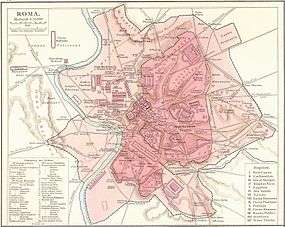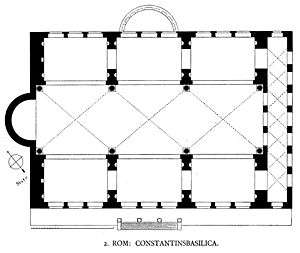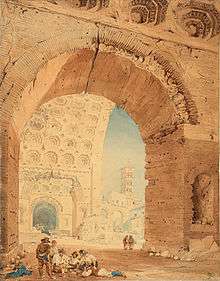Basilica of Maxentius
Coordinates: 41°53′30″N 12°29′18″E / 41.891775°N 12.488446°E
| Basilica of Maxentius | |
|---|---|
|
Remains of the Basilica of Maxentius and Constantine. The building's northern aisle is all that remains. | |
| Location | Regione VIII Forum Romanum |
| Built in | 312 AD |
| Built by/for | Maxentius, Constantine I |
| Type of structure | Basilica |
| Related |
List of ancient monuments in Rome |
 Basilica of Maxentius and Constantine | |

The Basilica of Maxentius and Constantine (sometimes known as the Basilica Nova - meaning "new basilica" - or Basilica of Maxentius) is an ancient building in the Roman Forum, Rome, Italy. It was the largest building in the Forum.
History
Construction began on the northern side of the forum under the emperor Maxentius in 308, and was completed in 312 by Constantine I after his defeat of Maxentius at the Battle of the Milvian Bridge.[1] The building rose close to the Temple of Peace, at that time probably neglected, and the Temple of Venus and Rome, whose reconstruction was part of Maxentius' interventions.

The building consisted of a central nave covered by three groin vaults suspended 39 meters above the floor on four large piers, ending in an apse at the western end containing a colossal statue of Constantine (remnants of which are now in a courtyard of the Palazzo dei Conservatori of the Musei Capitolini). The lateral forces of the groin vaults were held by flanking aisles measuring 23 by 17 metres (75 x 56 feet). The aisles were spanned by three semi-circular barrel vaults perpendicular to the nave, and narrow arcades ran parallel to the nave beneath the barrel vaults. The nave itself measured 25 metres by 80 metres (83 x 265 feet) creating a 2000 square meter floor. Like the great imperial baths, the basilica made use of vast interior space with its emotional effect.

Running the length of the eastern face of the building was a projecting arcade. On the south face was a projecting (prostyle) porch with four columns (tetrastyle).
The south and central sections were probably destroyed by the earthquake of 847.[3] In 1349 the vault of the nave collapsed in another earthquake. The only one of the eight 20-meter-high columns, which survived the earthquake was brought by Pope Paul V to Piazza Santa Maria Maggiore in 1614. All that remains of the basilica today is the north aisle with its three concrete barrel vaults.[1] The ceilings of the barrel vaults show advanced weight-saving structural skill with octagonal ceiling coffers. The wrestling events were held here during the 1960 Summer Olympic Games.

In ancient Rome a basilica was a rectangular building with a large central open space, and often a raised apse at the far end from the entrance. Basilicas served a variety of functions, including a combination of a court-house, council chamber and meeting hall. There might be, however, numerous statues of the gods displayed in niches set into the walls. Under Constantine and his successors this type of building was chosen as the basis for the design of the larger places of Christian worship, presumably as the basilica form had fewer pagan associations than those of the designs of traditional Greco-Roman temples,[4] and allowed large congregations. As a result of the building programmes of the Christian Roman emperors the term basilica later became largely synonymous with a large church or cathedral.
The color of the building before it was destroyed was white. On the outside wall of the basilica, facing onto the via dei Fori Imperiali, are contemporary maps showing the various stages of the rise of the Roman Empire which were added during the Fascist regime of Benito Mussolini. A map depicting Mussolini's "New Roman Empire" was removed from the wall after the war.
Engineering
The Basilica Maxentius is a marvel of Roman engineering work. At the time of construction, it was the largest structure to be built and thus is a unique building taking both aspects from Roman baths as well as typical Roman basilicas. At that time, it used the most advanced engineering techniques known including innovations taken from the Markets of Trajan and the Baths of Diocletian.
Similar to many basilicas at the time such as the Basilica Ulpia, the Basilica Maxentius featured a huge open space in the central nave, but unlike other basilicas instead of having columns support the ceiling the entire building was built using arches, a much more common appearance in Roman baths than basilicas. Another difference from traditional basilicas is the roof of the structure. While traditional basilicas were built with a flat roof, the Basilica Maxentius was built with a folded roof, decreasing the overall weight of the structure and decreasing the horizontal forces exerted on the outer arches.[5]
See also
- Colossus of Constantine, originally situated in the west apse of the Basilica.
References
- 1 2 Roth, Leland M. (1993). Understanding Architecture: Its Elements, History and Meaning (First ed.). Boulder, CO: Westview Press. pp. 30, 222. ISBN 0-06-430158-3.
- ↑ Glory After the Fall: Images of Ruins in 18th- and 19th-Century British Art. The Huntington. Retrieved 12 July 2015.
- ↑ René Seindal "Basilica of Maxentius - the last and largest basilica in the Roman Forum", Photo Archive, 2003-08-06, accessed November 7, 2010.
- ↑ Fazio, Michael; et al. (2009). Buildings across time : an introduction to world architecture (3rd ed.). Boston, Mass.: McGraw-Hill Higher Education. p. 134. ISBN 007305304X.
- ↑ Giavarini, Carlo., The Basilica of Maxentius: the Monument, its Materials , Construction, and Stability, Roma: L'Erma di Bretschneider, 2005.
Sources
- 1960 Summer Olympics official report. Volume 1. pp. 76, 79.
- The Roman Empire: From the Etruscans to the Decline of the Roman Empire, Henri Stierlin, TASCHEN, 2002, Edited by Silvia Kinkle, Cologne, ISBN 3-8228-1778-3
Further reading
- Weitzmann, Kurt, ed., Age of spirituality: late antique and early Christian art, third to seventh century, no. 103, 1979, Metropolitan Museum of Art, New York, ISBN 9780870991790; full text available online from The Metropolitan Museum of Art Libraries
External links
-
 Media related to Basilica of Maxentius at Wikimedia Commons
Media related to Basilica of Maxentius at Wikimedia Commons - A reconstruction at the Plan de Rome
